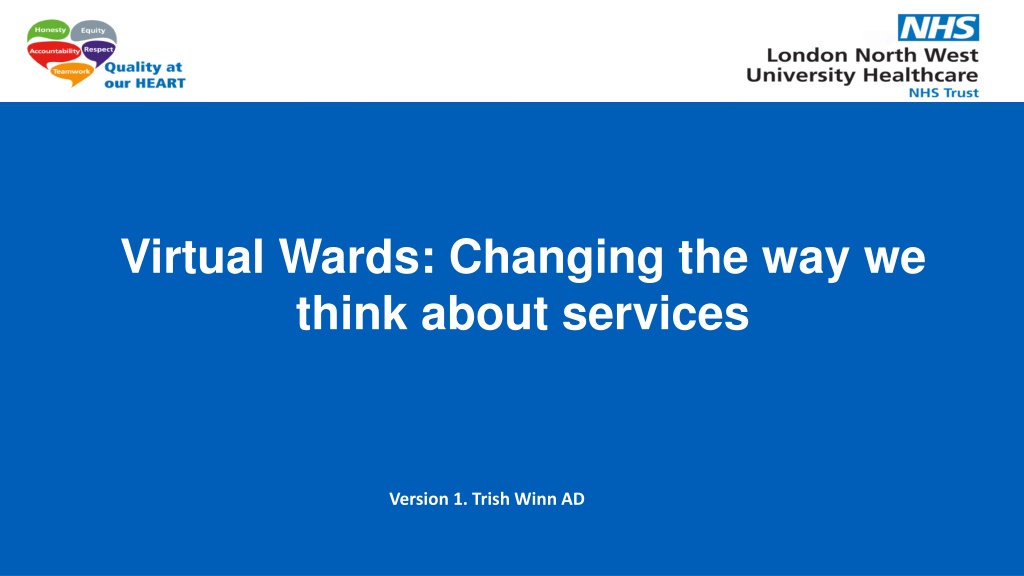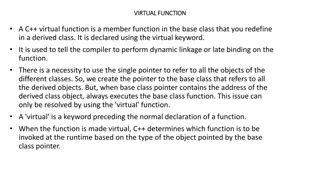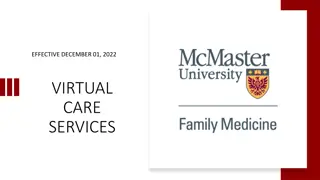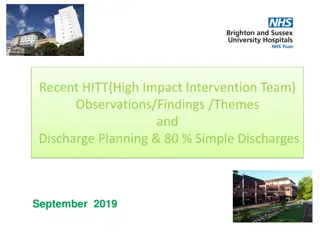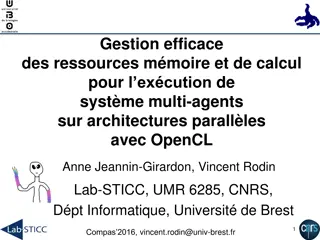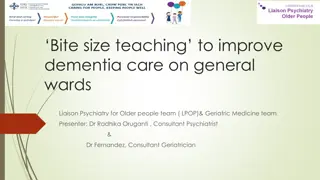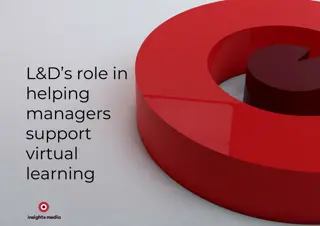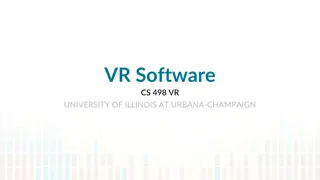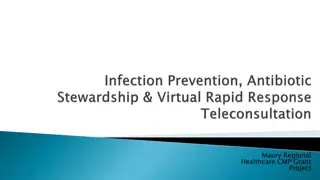The Evolving Landscape of Virtual Wards in Healthcare
The global COVID-19 pandemic has prompted a shift in healthcare delivery towards virtual wards, offering improved patient experiences, enhanced outcomes, and sustainable healthcare solutions. Virtual wards provide healthcare at home, reducing nosocomial infections and optimizing resource utilization. This paradigm shift aims to address the changing needs of patients while ensuring safe, effective care delivery.
Download Presentation

Please find below an Image/Link to download the presentation.
The content on the website is provided AS IS for your information and personal use only. It may not be sold, licensed, or shared on other websites without obtaining consent from the author. Download presentation by click this link. If you encounter any issues during the download, it is possible that the publisher has removed the file from their server.
E N D
Presentation Transcript
Virtual Wards: Changing the way we think about services Version 1. Trish Winn AD
Introduction The global pandemic of COVID 19 has been identified as a defining point in Healthcare history redefining how patients access acute care in an era where hospitals were seeing high levels of infectious patients, making them a less safer place for those needing specialist interventions and support of on going care. Following the first wave of the pandemic in 2020 my Trust identified that local patients were staying away from hospital even when deteriorating. To reduce this problem the Trust focused on Same Day Emergency Care services and the development of virtual pathways to support patient care
Why we need Virtual Wards? Improved patient experience and outcomes Shared decision-making for patients Improved patient flow by reducing admissions and length of stay. Reduced nosocomial transmission of infections including COVID-19 Better staff experiences Better use of resources (e.g. physical space) Sustainable healthcare delivery specially in context of a significant population with long term conditions and frailty
The world of virtual healthcare VIRTUAL WARDS VIRTUAL CARE Provides enhanced healthcare at home as an alternative to NHS bedded care. Provides enhanced healthcare at home, but not as an alternative to NHS bedded care. EXAMPLES EXAMPLES Stable patients, such as: Acute respiratory infection (ARI) virtual ward, such as: monitoring chronic diseases managing long-term conditions supporting ARI (e.g. oxygen saturation monitoring +/- oxygen, IV antibiotic or dexamethasone treatments) Escalating patients, such as: Frailty Hospital-at-Home, such as: using COVID-19 Oximetry @home to identify who needs admission using of RESTORE2 in care homes to identify signs of deterioration supporting frailty conditions that require multi-disciplinary team input and hospital-level care Others, such as: Acute care, such as: using virtual consultations with GPs or acute hospitals General medical conditions (e.g. heart failure, infection, COPD) Paediatric conditions (e.g. asthma, wheeze, phototherapy) End-of-life care Perioperative care, such as: assessing pre-operative patients managing their wounds post-operation 4
Our Planning through FY 21-22 | To rapidly explore, score and stand-up virtual wards across select clinical pathways June-July Aug-Sept Sept-Oct October onwards Develop Business Case & Implementation Plan Explore Clinical Pathways To agree operational model Implement
Virtual Ward Pathways: Current Status Planned steps Pathway Operational since July 21 7 day patient pathway Heart Failure Operational since Jan 21 Cover available to manage up to 30 patients Staff proving other support during low activity COVID Operational since Dec 2022 Recruitment of Staff delayed the programme start. Presently fully staffed and working with early supported discharge team average of 30 patients Respiratory Working with Sector to identify virtual ward cohort Operational since Dec 2022 Digital pathway configuration in development, SOP draft ready IBD Leading Trust for standardisation of care for NW London ICB. Patient feedback has been amazing. Average of 15 patients Diabetes Operational since Jan 2023 Development of IV Monitoring of patients on high level antibiotic therapy administering QDS Therapy and review. Small patient cohort but average hospital stay 2-6 weeks. Acute Infection
Virtual Ward Pathways | Numerous Pathways have been identified within LNWH Heart Failure Atrial Fibrillation COPD Interstitial Lung Disease Bronchiectasis Low risk pneumonia IBD Frailty COVID patients Sickle Cell Diabetes Conditions requiring intravenous antibiotics in otherwise clinically stable and improving patient
Changing the Culture Changing the Culture What we did Challenges Cross specialist and cross organisation working within existing resources Building new pathways without agreed funding approach Oversight, assurance and support for planning & delivery Maximising benefits due to resource constraints including community support Constraints to address equality Compliance and risk management including risks due to digital ways, equipment management Pandemic priority slowed pace and delivery Developed relationships with clinical teams to support dialogue Piloted and tested pathways using pre and post interventional data to support funding Developed governance processes to ensure organizational oversight Developed benefit profile. Piloted and tested pathways using pre and post interventional data to support funding Modelled resource requirement in line with other quality targets Monitored equality of care delivery and focused on why patients were not on boarded Identified the worth of virtual ward in reducing admissions
Changing the Culture Changing the Culture Clinical Engagement: Empowered clinicians to build the pathway and have ownership of the process and speed of change Pathway Development : Owned by clinical teams and visualised how the process would work and who would be involved Developing the Virtual Ward Programme Model Measuring and monitoring : Gave a clear identification of which patients were eligible and supported business case development for resource Benefit realisation: Gave evidence of clinical benefit patient experience and cost effectiveness
Our Experience Clinical Engagement Version 1.4 Trish Winn
Our Experience Our Experience Key to clinical engagement was the acknowledgement of the following: One size doesn t fit all Clinical Staff need to own the process as they are best positioned to identify acuity and cohort of the patient The process of onboarding needs to be within the current workload of the clinical team Identification of resource can be difficult True engagement bears fruit in showing others how they can implement change
Our Experience Pathway Development Version 1.4 Trish Winn
Approach | From Idea to Implementation Implementation/ Milestones Stakeholders Challenges Idea Opportunity Clinical Team willing to innovate and try new ways of working Trust COVID virtual ward in operation Virtual ward programme established Clinical Pathway Referral Process Luscii Set Up Training Staffing clinical & non-clinical SOP Equipment Management IG and Digital Compliance Setting up clinical system & coding Patient Education Material Project Risk Review Communication for go live Go live Test Recurrent admissions Inability to support patient once discharged after admission and Heart Failure Lounge attendance Workload in CNS Clinics CCG funding available HF Clinical Nurse Specialist Cardiology Consultants Operational Colleagues Transformation and QI Team Clinical team approached Plan agreed to run this model
Overview of LNWH Heart Failure Virtual Ward Referral and Operational Process Map Location Escalation Referrals, Review & Onboarding) Decision and Outcome Patient under HF community Team* Pt called in for a HF lounge review Heart Failure Community Team /ICM case management Stable @ Home Pt Follow in-patient referral pathway Rapid Response and or ICM. 3-5 days IV oral diuretics (BD only ) Bloods .optimised and discharged from virtual ward ICM case management Refer to HF VW- bleep for review Needs admission ED Onboarding 8-weeks Information sheet Consent Care plan Parameters set Drug titration Equipment Rapid Response Meets HF nurse referral & review inclusion/exclusion criteria Needs Physical review/ Intervention HF lounge Monitoring commenced ESD within next 4 days Inpatient Reviewed & sent home HF Community Team or Rapid Response (Note below) Outpatient Clinic Pt deteriorates and needs hospital admission ED ICM case management No patient accepted on this referral pathway currently GP Patient under Ealing community only with no current physical hospital attendance (ED/SDEC/in patients or clinics) are not accepted currently through this route (Luscii monitoring) due to constraints of processes Process Start Note: Full Head to Toe assessment and appropriate direct onward referral to specialist community services Process Ends
Our Experience Measuring and Monitoring Version 1.4 Trish Winn
Virtual Ward Statistics Virtual Ward Implementation Trajectory to meet 80% Occupancy Virtual Ward Statistics Virtual Ward Statistics The Trust was set a target to have 109 virtual ward beds in place by end of 2023 with an aim to have 80% occupancy by September 2023. Trust has achieved 80% occupancy at the end of March 2023 140 120 NWL ICB has recorded 867 patients on the virtual ward up to the end of March 2023 Virtual Wards in place for the following Heart Failure 33 Diabetes 15 Respiratory 10 Acute Infection 4 Pediatrics 32 100 80 60 40 20 0 5/12/2022 6/12/2022 7/12/2022 9/12/2022 10/12/2022 11/12/2022 12/12/2022 Number of patients 8/12/2022 1/12/2023 2/12/2023 3/12/2023 Target 80% occupancy
Ensuring Equity of Care Ensuring Equity of Care Clinical team wanted to understand whether there was equity of care to support virtual ward pathway Developing the Virtual Ward Programme Model We completed a review of patients demographics for all patients assessed for virtual ward onboarding Analysis showed demographic mix was representative of patient cohort. there was however barriers to patients accessing digital programme. Our solution was to engage with tech partners to improve access to Wi-Fi and equipment and to set up alternative support such as face to face interventions and telephone calls
Ensuring Equity of Access We aim to give access to all clinically appropriate patients access to their care through the virtual ward. We are monitoring equity of access for patients from different ethnicities Number of Patients Accessing Heart Failure Virtual Ward by Ethnicity 25 20 15 10 5 0 ASIAN - INDIAN WHITE - BRITISH ASIAN - ANY OTHER BACKGROUND NOT STATED OTHER - ANY WHITE - ANY OTHER BACKGROUND BLACK - CARIBBEAN WHITE - IRISH BLACK - AFRICAN ASIAN - PAKISTANI ASIAN - BANGLADESHI BLACK - ANY OTHER BACKGROUND OTHER Number of Patients Percentage of pateints
Identifying the barriers to accessing Identifying the barriers to accessing digital care digital care Not Suitable 57 Not Suitable 57 Specialized Care Specialized Care 15 15 Compliance Issues Compliance Issues 8 8 Heart Failure Clinic 283 No Access Smartphone No Access Smartphone 71 71 New CHFN Referral 109 Struggles with Technology Struggles with Technology 103 103 392 TOTAL Language barrier Language barrier 37 37 *1 patient can have more than one reason for not being recruited or on-boarded onto VW Frail 115 Frail 115 Declined / Refused Declined / Refused 12 12 0 20 40 60 80 100 120 140 0 20 40 60 80 100 120 140
Our Experience Benefit Analysis Version 1.4 Trish Winn
A glance at Heart Failure Virtual Ward Benefit Summary | | Positive patient experience- feedback on the portal 30-day readmission rate on heart failure virtual ward 1.25% versus 25% those without virtual ward Estimated Bed days Saved 985 Total number of patients to date= 287 Current Caseload=35 70% of patients have been titrated to best practice medication Against 40% nationally Positive staff experiences Proof of Concept to build our virtual ward pathway Innovative Model presented through national conferences Reduced nosocomial transmission of infections including COVID-19 through care close to home Better use of resources (physical space, staffing) helped secured NHSX Digital Partnership Award for the ICS International Nursing Award
What are the key benefits? Number of patients Date Range from 01/07/2021 to 31/08/2022 128 Review of patient data has better outcomes for the system including reductions in ED attendances Re-admissions Total Bed days stayed Resulting in a reduction in average length of stay from 9.95 days to 2.25 days ED Attendances Pre Intervention ED Attendances Post Intervention Reduction in ED Attendances Percentage reduction 216 58 158 73.14% Admissions Pre Intervention Admissions Post Intervention Reduction in admissions Percentage reduction 165 51 114 69.09% bed days Post intervention bed days pre intervention Reduction in bed days Percentage reduction 1273 288 985 77.37% Average Los Pre intervention Average Los post intervention 9.95 2.25
Patient Experience Virtual Wards Respiratory Virtual Ward Elaine COPD She said: I d heard about virtual wards, though initially I was a bit reticent when I read the information leaflet. However, once it was explained by the nurses, I thought it would be beneficial. It also meant I could return home quicky instead of taking up bed space from others who may need treatment. I was monitored for 14 days using the Luscii App, a remote monitoring platform. The app was pretty straight forward to use, as I would get a daily email reminding me to input my data, such as oxygen saturations, heart rate, or when I was I coughing. Mary Bup, Clinical Lead Nurse, STARRS, added Elaine s treatment via the virtual ward has been a positive experience for the team as it allowed us to monitor her condition remotely. By moving her on to the virtual ward, Elaine avoided spending five to six days in hospital, which meant freeing up space on the ward for other patients.
Patient Experience Virtual Wards Julian Marshall has been a type 1 diabetic for eight years. During that time he has struggled to understand what he needs to do in order to manage his condition and live a happy, healthy life. Last year, whilst abroad on holiday, he was hospitalised for diabetic ketoacidosis (DKA), which occurs when the body starts to run out of insulin. However, since then, his experience has taken a more positive turn, in part due to virtual ward. My recent trip to Northwick Park Hospital was due to more complications. During that visit I felt I was blessed to meet with Denisse. She is a kind soul and embodies everything I would expect from a nurse. As far as my experience on the Virtual Ward, it has been by far the best thing I ve been offered as a form of treatment. Diabetes Virtual Ward My fianc and I have spoken at length about how positive it had been in helping me manage my condition. I used a sensor-based glucose monitoring system, which eliminates the need for painful routine finger pricks. Denisse would call me every day and speak about the sensor scans, as well as going over what I ate, and how much exercise I did. He added: The virtual ward was vital in helping me change my attitude towards managing my health, but so was Denisse. I cannot thank her enough for her encouragement when I was having a bad day, feeling low, and burnt out. She would lift me out of the hole I was in and tell me how good I was doing.
Existing Challenges Existing Challenges Clinical Engagement: continued pressure on recovery pathways for elective care can mean lack of clinical capacity to try innovative pathways Pathway Development : from proof of concept to national imperative in 0-60 seconds. Pressure to stand up pathways from centre can disable innovation Developing the Virtual Ward Programme Model Measuring and monitoring : defining what is virtual ward and what is remote monitoring is key to progression. Understanding that patients don t fit into a box Benefit realisation: Lack of direction regarding how benefits are captured and how funding is released to support them. Use of digital and non-digital pathways some patients need face to face interventions
Any Questions? Version 1.4 Trish Winn
